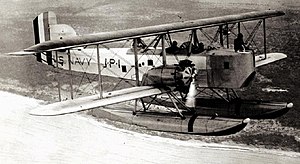m (Remove some templates. interwiki links, delink non military terms and cleanup, replaced: {{USA}} → United States) |
m (Remove some templates. interwiki links, delink non military terms and cleanup) |
||
| Line 6: | Line 6: | ||
{{Infobox Aircraft Type |
{{Infobox Aircraft Type |
||
|type = [[Torpedo bomber]] |
|type = [[Torpedo bomber]] |
||
| − | |manufacturer = |
+ | |manufacturer = Douglas Aircraft Company |
|designer = |
|designer = |
||
|first flight = 27 January [[1927 in aviation|1927]] |
|first flight = 27 January [[1927 in aviation|1927]] |
||
| Line 24: | Line 24: | ||
==Development and design== |
==Development and design== |
||
| − | In 1925, the [[United States Navy]]'s [[Bureau of Aeronautics]] designed a twin-engined [[torpedo bomber]] aircraft, intended to have greater performance than contemporary single-engined aircraft.<ref name="US Navy 1911">{{cite book|last=Swanborough|first=Gordon|coauthors=Bowers, Peter M.|title =United States Navy Aircraft since 1911|edition=Second edition|year=1976|publisher=Putnam|location= London|pages=161–162|isbn=0-370-10054-9}}</ref> A single prototype was built by the [[Naval Aircraft Factory]] as the '''XTN-1''', which was quickly followed by three identical aircraft built by |
+ | In 1925, the [[United States Navy]]'s [[Bureau of Aeronautics]] designed a twin-engined [[torpedo bomber]] aircraft, intended to have greater performance than contemporary single-engined aircraft.<ref name="US Navy 1911">{{cite book|last=Swanborough|first=Gordon|coauthors=Bowers, Peter M.|title =United States Navy Aircraft since 1911|edition=Second edition|year=1976|publisher=Putnam|location= London|pages=161–162|isbn=0-370-10054-9}}</ref> A single prototype was built by the [[Naval Aircraft Factory]] as the '''XTN-1''', which was quickly followed by three identical aircraft built by Douglas, the '''T2D-1'''. |
The XTN/T2D was a large two bay [[biplane]], capable of easy conversion between floats and wheels, and carrying a crew of four. |
The XTN/T2D was a large two bay [[biplane]], capable of easy conversion between floats and wheels, and carrying a crew of four. |
||
| Line 72: | Line 72: | ||
|max takeoff weight alt=4,773 kg |
|max takeoff weight alt=4,773 kg |
||
|engine (prop)=[[Wright Cyclone|Wright R-1750 Cyclone]] |
|engine (prop)=[[Wright Cyclone|Wright R-1750 Cyclone]] |
||
| − | |type of prop=9-cylinder single row |
+ | |type of prop=9-cylinder single row radial |
|number of props=2 |
|number of props=2 |
||
|power main=525 hp |
|power main=525 hp |
||
Revision as of 04:15, 6 December 2013
| T2D | |
|---|---|
| Douglas T2D-1 of VP-1 | |
| Role | Torpedo bomber |
| Manufacturer | Douglas Aircraft Company |
| First flight | 27 January 1927 |
| Introduction | 1927 |
| Retired | 1937 |
| Primary user | United States Navy |
| Number built | 31 |
The Douglas T2D was an American twin engine torpedo bomber contracted by the military, and required to be usable on wheels or floats, and operating from aircraft carriers. It was the first twin-engined aircraft to be operated from an aircraft carrier.[1]
Development and design
In 1925, the United States Navy's Bureau of Aeronautics designed a twin-engined torpedo bomber aircraft, intended to have greater performance than contemporary single-engined aircraft.[1] A single prototype was built by the Naval Aircraft Factory as the XTN-1, which was quickly followed by three identical aircraft built by Douglas, the T2D-1.
The XTN/T2D was a large two bay biplane, capable of easy conversion between floats and wheels, and carrying a crew of four.
Operational history
The first three T2D-1's were delivered to the torpedo bomber squadron VT-2 on 25 May 1927,[1] being used for successful trials aboard the aircraft carrier Langley. A further nine T2D-1's were ordered in 1927, these normally being operated as floatplanes, partly owing to criticism from the Army of the Navy operating large land based bombers,[1] and partly as its large size prevented Langley from embarking a full airwing.[2]
A further 18 aircraft were ordered in June 1930 as patrol floatplanes, being designated P2D-1. These were operated by Patrol Squadron VP-3 in the Panama Canal Zone until they were replaced by Consolidated PBYs in 1937.[1]
Variants
- XTN-1
- Original prototype built by Naval Aircraft Factory. One built.
- T2D-1
- Production aircraft, convertible torpedo bomber/patrol floatplane, powered by Wright R-1750 Cyclone. 12 built.
- P2D-1
- Dedicated patrol floatplane. Fitted with twin tail for improved engine out performance and powered by two R-1820 Cyclones. 18 built.
Operators
Specifications (T2D)
Data from The Encyclopedia of World Aircraft [2]
General characteristics
- Crew: 4
- Length: 42 ft (12.80 m)
- Wingspan: 57 ft (17.37 m)
- Height: 15 ft 11 in (4.85 m)
- Wing area: 886 ft² (82.31 m²)
- Empty weight: 6,011 lb (2,726 kg)
- Max. takeoff weight: 10,523 lb (4,773 kg)
- Powerplant: 2 × Wright R-1750 Cyclone 9-cylinder single row radial, 525 hp (391 kW) each
Performance
- Maximum speed: 109 kn (125 mph, 201 km/h)
- Range: 397 nmi (457 mi, 735 km)
- Service ceiling: 13,830 ft (4,215 m)
- Rate of climb: 1,000 ft/min (304.8 m/min)
- Wing loading: 12.2 lb/ft² (58.0 kg/m²)
- Power/mass: 0.10 hp/lb (0.16 kW/kg)
Armament
References
- ↑ 2.0 2.1 Donald, David, The Encyclopedia of World Aircraft (pg 118). (1997). Prospero Books. ISBN 1-85605-375-X
External links
| Wikimedia Commons has media related to Douglas military planes. |
| ||||||||||||||||||||||||||||||||
| ||||||||||||||||||||||||||||||||||||||||||||||||||||||||||||||||||||||||||
| |||||||||||||||||||||||||||||||||||||||||||||||||||||||||||||||||||
Template:Aviation lists
